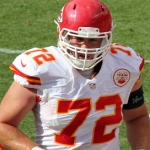
Football is gearing up, and already the Chiefs have someone on their injury list. Fortunately, Eric Fisher (tackle), only has a sprain and should be ready to return in a few weeks. So we know its not broken, but we are still left with the question “what exactly is a sprain?”
Sprain
“A sprain is a stretch and/or tear of a ligament, a strong band of connective tissue that connect the end of one bone with another. Ligaments stabilize and support the body’s joints.” (AAOS) A sprain can happen at every joint in the body but the most common sprains occur in the Ankle, knee, shoulder and wrist.
When you sprain a ligament it stretches the tissue causing pain and inflammation. Sprains are categorized in severity.

Grade I:
-A stretch of the ligament but no tearing.
Grade II:
-Partial tearing of the ligament with some looseness of the joint.
Grade III:
-Complete tear of the ligament with instability of the joint.
A high ankle sprain is a little different than a “traditional ankle sprain” where the foot turns in or you “roll your ankle.” A high ankle sprain is traditionally called a Syndesmotic sprain. A high ankle sprain typically requires a longer rehabilitation period due to its mechanism of injury. Unlike a lateral ankle sprain, a rolled ankle, a high ankle sprain is a sprain of the syndesmosis which is the connective tissue of the tibia and fibula (the two lower leg bones that make up the shin and ankle).
In rare cases, ankle sprains require surgery, though most often are treated with non-operative treatment. In the setting of an acute ankle sprain, immobilization may be required for a short window. This is typically followed by rest, ice, elevation, NSAID’s and most important, physical therapy. There is no quick fix for an ankle sprain. It is important to continue your home exercises on a regular basis following an ankle sprain, as there is the risk for recurrent ankle problems.
Author: Stephanie Jones, AT & Darci Mertz
Sources:
http://orthoinfo.aaos.org/topic.cfm?topic=A00111
http://www.aaos.org/news/aaosnow/apr12/clinical1.asp
http://us4.campaign-archive1.com/?u=8b6d1bbbe68a1d9b33dcc06a9&id=70c880c637&e=17ee6a6034

